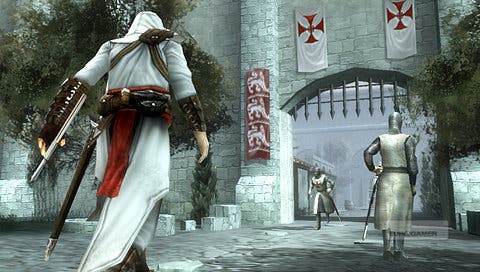Assassin's Creed: Bloodlines
Moving targets.
If there is one area in which Assassin's Creed: Bloodlines exceeds expectations, it is in the volume of chickens stalking Cyprus in the Middle Ages. They are everywhere. In the streets, in the marketplaces, in the churchyards - they're even on the rooftops. You can't free-run more than a few metres without encountering a chicken.
If there are two areas in which Assassin's Creed: Bloodlines exceeds expectations, however, surely the second is that Gryptonite Games has built a series of openworld levels with very small loading times separating them, and that you can traverse each of them in much the same way you can in the PC and console versions. What's more, the frame-rate is good and there's a surprising amount of detail: your flowing assassin uniform, the vines, haybales, civilians, etc. Did I mention the chickens?
However, exceeding expectations was never really going to be Bloodlines' problem, because nobody expected very much from this - apart from six unlockable weapons for use in the PS3 version of Assassin's Creed II. No, the problem was always going to be whether Gryptonite would simply coax a passable impression of Assassin's Creed out of the PSP, or whether it could do more.
Rather than copying the excellent Assassin's Creed II by plunging you into Renaissance Italy, Bloodlines returns you to Altair right after the end of the first game. The idea in the Assassin's Creed series is that you are really a captive descendant of Altair in the present day, and you are reliving genetic memories in a machine called the Animus, but according to Assassin's Creed II you don't go back to Altair to relive any more memories after the events of the first game, so Bloodlines doesn't make sense. Then again, if you can forgive that and do care about the Assassin's Creed storyline, you will at least find out what Altair did with the Apple of Eden. And if you're new and have absolutely no idea what I'm talking about, don't worry, I barely do either.

The important things to bear in mind are that Altair is a medieval assassin, he's basically king of the assassins at this point, and he's off to Cyprus to sort out the evil Templar knights, who are trying to recover their power after his crushing one-man smackdown at the end of the first game.
The continuity does at least stretch to giving you most of Altair's abilities straight from the off. Walking around by default, he can also run and climb onto pretty much anything, since all the world in Assassin's Creed is peppered with convenient hand-holds. There's a mini-map showing you objective markers and side missions, and the streets are patrolled by guards marked in yellow, who react suspiciously to anything more than a cautious stroll with your hands clasped together in prayer. It's a bit like a particularly strict swimming pool - sometimes men draw their swords and bark, "Who's that running over there?!"


